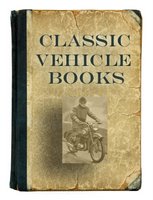Triumph Of Triumph
'The Triumph Of Triumph' An Article By Alan Liptrot
History sometimes throws up some strange truths, no more so than that which tells us, that the most British of motorcycles owes its existence to a German. One Seigfried Bettmann, an immigrant from Nuremberg, began a company named the 'S.Betmann & Co. Import Export Agency' in London in 1884. As an ambitious 20 year old, Bettmann bought and sold bicycles and imported sewing machines from Germany. In 1886, when he changed the name of the company to the 'Triumph Cycle Company', a name synonymous with British bikes was born. A further name change along with financial backing from Dunlop a year later, saw the birth of the 'New Triumph Co. Ltd'. Another significant development of that same year was the arrival of fellow countryman Moritz Schulte.
With encouragement and capital from Schulte, Bettman purchased a site in Coventry, and in 1889, began building the first bicycles to carry the Triumph badge, but it wasn't until 1902 that the marquee was attached to a motorcycle. This first motorbike was in fact a bicycle fitted with a Belgian engine. In 1903, as production rose to more than 500 units, Triumph began building machines in their German factory. At the outset, the company built motorbikes based on models from other manufacturers, however, in 1904/5 Triumph came up with their own design which reached sales of 250.
When production topped 1,000, the company opened a larger factory and launched the 'Gloria' brand, aimed at the lower end of the market. At this time, a decision was made to rebrand the German made motorbikes as 'Orial'. Unfortunately, 'Orial' already existed in France, so the company became 'TWN'; 'Triumph Werke Nurnberg'.
As so often happens, conflict brings dividends to some, and Triumph flourished during the First World War, supplying in excess of 30,000 units to the allies. It was at this time that the Model H Roadster gained its tag of 'The Trusty Triumph'. The irony of two Germans producing the archetypal British motorbike to fight the Kaiser has been lost on many. After the war, Bettmann and Schulte couldn't agree about the issue of car manufacture, and Schulte decided to leave the company. In 1920, the company bought the former Hillman car factory in Coventry, and by 1923 had produced the first car bearing the name of The Triumph Motor Company.
By the middle of the 20's, the company had grown into one of the leading car and motorcycle producers in the country, with a capacity of 30,000 cars and motorcycles annually. However, the good times were about to end with the arrival of the Great Depression. The German arm became a separate company and continued producing TWN motorbikes until 1957. The bicycle manufacturing side of the company was sold to Raleigh in 1932, and Bettmann was under pressure. He retired in 1933.
In 1936, the car and motorcycle sectors were separated and became independent companies. The car division had always struggled to make a profit, and went bankrupt in 1939, finally being purchased by the Standard Motor Company. The motorcycle division found things easier, and after being acquired by Jack Sangster, the owner of the rival Ariel Company, began exporting machines to the USA. Sangster brought his design team with him, including Edward Turner, the designer of the 500cc Speed Twin, which became the bedrock for all Triumph twins until the 1980's. Coventry remained the home of Triumph motorcycles until the Second World War, however, the city was all but destroyed by German bombing, and moved to a new plant at Meridan, West Midlands in 1942.
The post war years were Triumph's Golden days, and the company received a huge fillip when Marlon Brando rode a Thunderbird 6T in the film 'The Wild One'. In 1951, the company was sold to rivals BSA, with Sangster becoming a member of the BSA board. Eventually, he rose to the position of Chairman.
After struggling to compete with Japanese imports, the company's fortunes declined, and after various changes in ownership, was acquired by former plasterer John Bloor in 1983. He was determined to keep the company alive, and preserve the title of ' The World's Longest Continuous Production Motorcycle Manufacturer'. The new company was initially named 'Bonneville Coventry Ltd.'. Spares manufacturer Lee Harris continued with production of the Triumph Bonneville until 1988. Triumph now produce a range of motorcycles that preserve the past model names, such as the Bonneville Twin.
Alan Liptrot is the founder of Motorbike Tours.co.uk The Company offers guided motorcycle tours in Spain, Portugal and Morocco.
More Motorcycle Articles By the same author
Check Out The Triumph Motorcycle Books
Classic Motorcycle Books
- General Classic Motorcycle Books
- Classic American Bike Books
- Classic Australian Bike Books
- Classic Austrian Bike Books
- Classic British Bike Books
- Classic Czech Bike Books
- Classic German Bike Books
- Classic Italian Bike Books
- Classic New Zealand Bike Books
- Classic Spanish Bike Books
- General Interest Motorcycle Books





